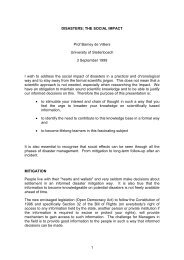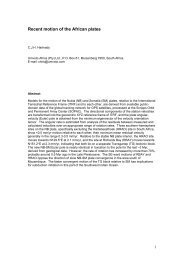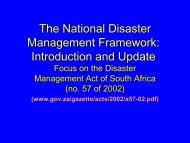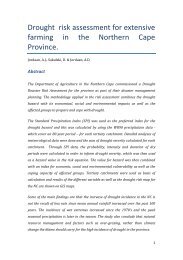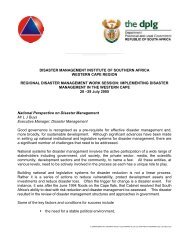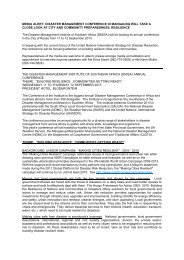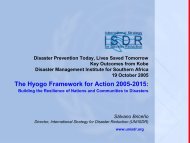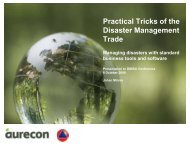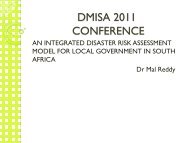BS Ngcamu, Dr. N Dorasamy - Disaster Management Institute South ...
BS Ngcamu, Dr. N Dorasamy - Disaster Management Institute South ...
BS Ngcamu, Dr. N Dorasamy - Disaster Management Institute South ...
- No tags were found...
Create successful ePaper yourself
Turn your PDF publications into a flip-book with our unique Google optimized e-Paper software.
as a mitigation strategy for the forthcoming predicted floodwaters. Moreover, the holy Bible speaks of manydisasters that hindered civilisations.Early disaster management strategies include inter alia, the promulgation of the United State ofAmerica (USA) Congressional Act of 1803 which was passed to provide financial assistance to a NewHampshire town that had been devastated by fires (Haddow et al., 2006:2). Another notable example is thatof the cold war era where the nuclear war was seen as a potential disaster threat. <strong>Disaster</strong> preparednessattempt to forecast extreme events, attempt to mitigate the impact of disasters, respond to disastersand cope with consequences of disasters. Strategies for disaster preparedness include awareness ofevent that is most likely to happen at a particular time and at a specific geographical location, riskand vulnerability assessment, response mechanisms, coordination, information management, andthe implementation of early-warning systems International Federation of Red Cross and RedCrescent Societies (IFRC), 2000:34).Allen (2006), cited in Yohe, Lasco, Arnell, Cohen, Hope, Janetos & Perez (2007:820) indicates thatthe bottom-up approach to disaster risk reduction is based on enhancing the capacity of localcommunities to adapt to and prepare for disasters. Actions in this approach include dissemination oftechnical knowledge and training, awareness raising, accessing local knowledge and resources, andmobilizing local communities. Blanco (2006), cited in Yohe et al. (2007:820), attests that climatechange can be incorporated in this approach through awareness and the transmission of technicalknowledge to local communities. Bridging the gap between scientific knowledge and localapplication is a key challenge.The International Federation of Red Cross and Red Crescent (2000:6) indicate that vulnerabilityanalysis is useful because information is needed in the pre-disaster phase including collecting andanalysing information necessary for preparedness planning. The International Federal of Red Crossand Red Crescent Societies (2000:6) indicate that disaster program planners increasingly usevulnerability information to refine their preparedness plans. Furthermore, vulnerability analysisideally provides indications of where the effects of disasters are likely to be the most pronounced(for example, by region and population). It is important for development planners to make someeffort to quantify the tangible aspects of vulnerability and loss to assist preparedness planning.Local experience is a good guide to what is vulnerable in a society, and the list of potentiallyvulnerable elements should be supplemented by a study of written reports and the knowledge ofthose who lived through previous disasters (Coburn, Pomonis, Sakai & Spence, 1991:32). This4



